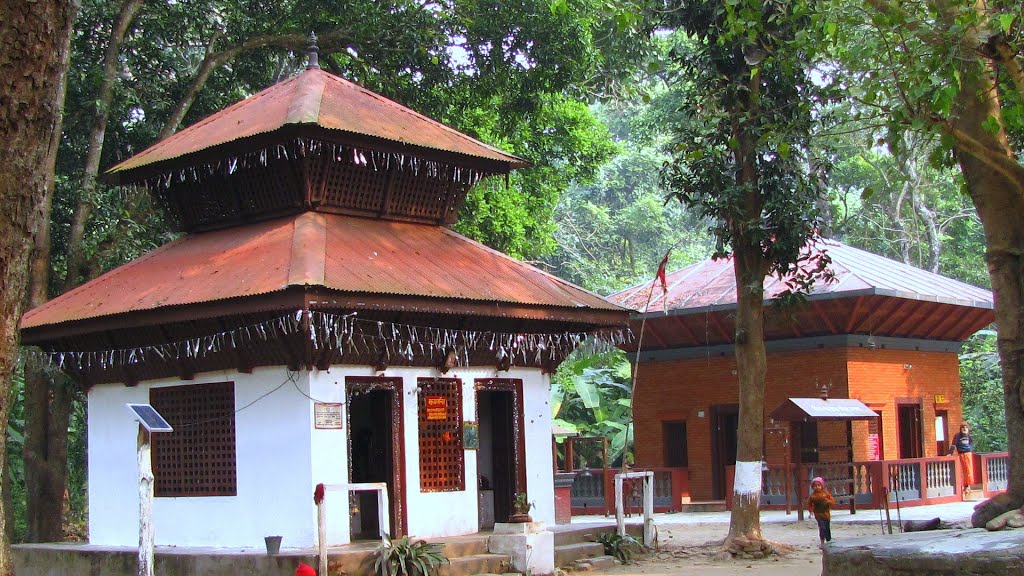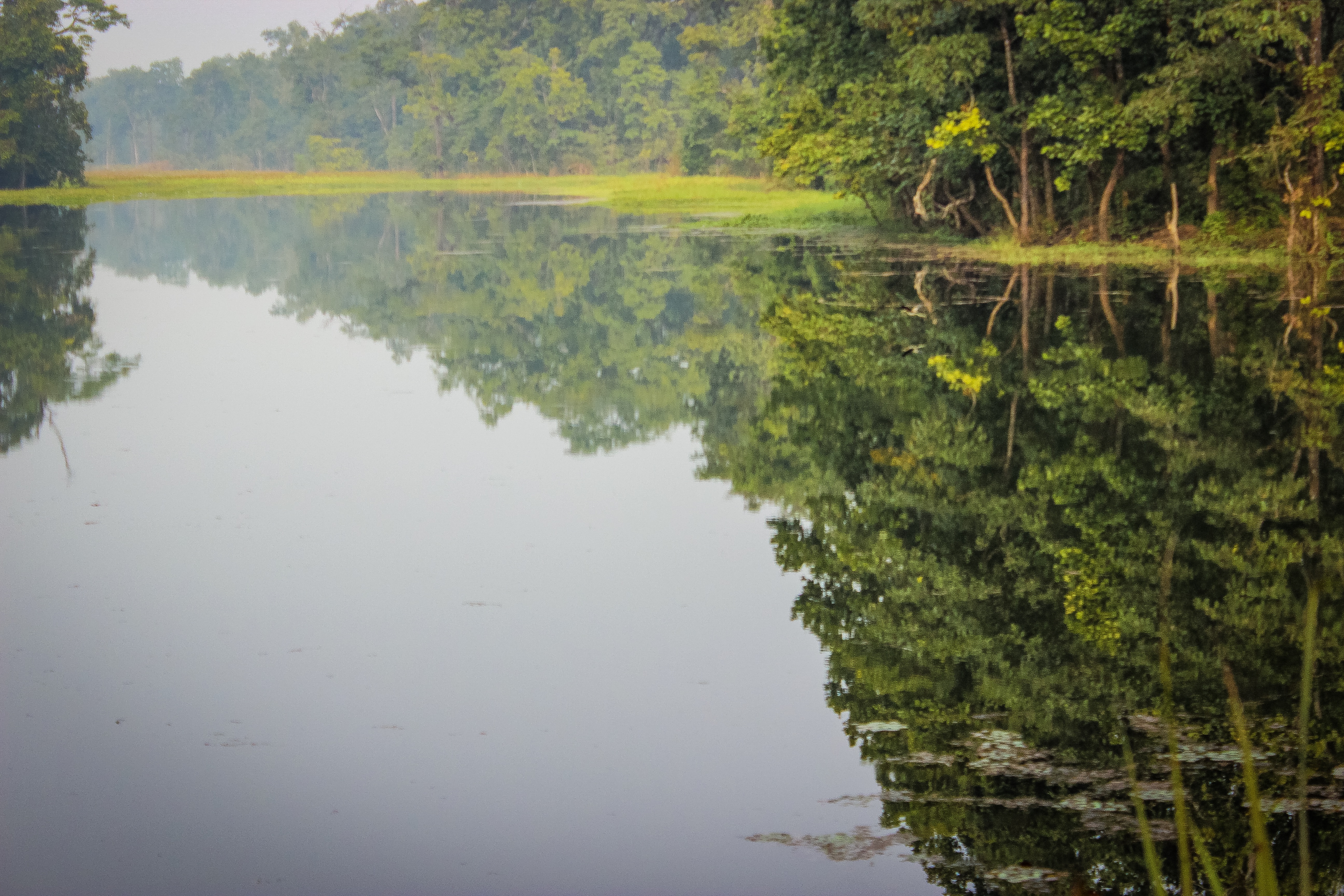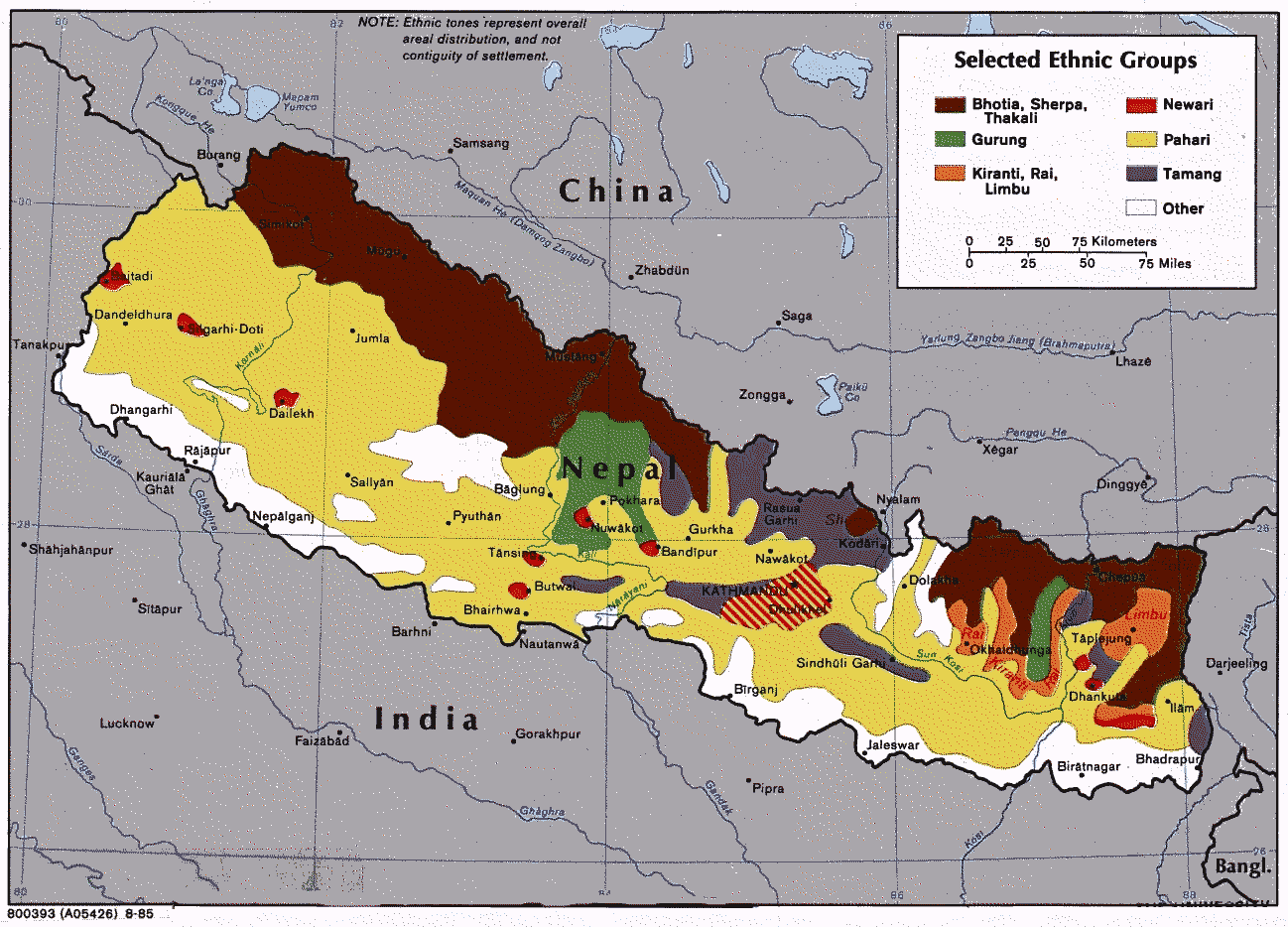|
Chitwan District
Chitwan District (, , ) is one of seventy-seven districts of Nepal, and takes up the southwestern corner of Bagmati Province. Bharatpur, largest city of Nepal after Kathmandu, is its administrative centre. It covers , and in 2011 had a population of 579,984 (279,087 male and 300,897 female) people. Bharatpur is the commercial and service centre of South Central Nepal and a major destination for higher education, health care and transportation in the region. Chitwan lies in the Terai region of Nepal. It is in the drainage basin of the Gandaki River and is roughly triangular, taking that river as its meandering northwestern border, and a modest watershed border, with India, as the basis of its southern limit. Local government: Bharatpur Metropolitan, Rapti Municipality, Ratnanagar Municipality, Kalika Municipality, Khairahani Municipality, Madi Municipality, Ikshyakamana Gaupalika History The district takes its name from the Chitwan Valley, one of Nepal's Inner Terai valleys ... [...More Info...] [...Related Items...] OR: [Wikipedia] [Google] [Baidu] |
Narayangarh, Chitwan
Bharatpur (, , ) is a city in south central Nepal. It is the third most populous city of Nepal after Kathmandu and Pokhara with 369,377 inhabitants in 2021. It is also the second largest metropolitan city in Nepal by area. It is the district headquarter of the Chitwan District. Bharatpur is one of the fastest-growing cities in Nepal. It lies on the eastern bank of the Narayani River and serves as a commercial center of the Chitwan district and the central region of Nepal. Most of the shopping area lies in the area of Narayangadh, while government offices, hospitals and colleges are situated in other parts of the city, including Nepal's premier cancer hospital, B.P Koirala Memorial Cancer Hospital. In March 2017, Bharatpur was declared a metropolitan city after Narayani Municipality, Chitrawan Municipality and Kabilas Village were merged into it. Economy The economy of Bharatpur is traditionally based on agriculture. The city also holds a small-scale processing industry ... [...More Info...] [...Related Items...] OR: [Wikipedia] [Google] [Baidu] |
Magars
The Magars, also spelled Mangar and Mongar, are the largest ethnic group native to Nepal and Northeast India, representing 6.9% of Nepal's total population according to the 2021 Nepal census. They are one of the main Gurkha tribes. The first home of the Magars was to the west of the Gandaki River and, roughly speaking, consisted of that portion of Nepal which lies between and around about Gulmi District, Gulmi, Arghakhanchi District, Arghakhanchi, and Palpa District, Palpa. This part of the country was divided into twelve districts known as ''Bahra Magarat'' (Confederation of Twelve Magar villages), which included the following regions of that period: Argha, Arghakhanchi District, Khanchi, Bhirkot, Dhor, Garhung, Ghiring, Gulmi, Isma, Musikot, Rising, Satungal, Satung, and Pyung. During the medieval period, the whole area from Palpa District, Palpa to Rukum Rolpa was called the Magarat, a place settled and inhabited by Magars. Another confederation of eighteen Magar kingdoms, k ... [...More Info...] [...Related Items...] OR: [Wikipedia] [Google] [Baidu] |
Chepang Language
Chepang is a language spoken by approximately 59,000 people in South-Central Nepal. The people are known as Chepang. In 2003, Randy LaPolla proposed that the Chepang may be part of a larger " Rung" group. Another group who speaks Chepang, living across the Gandaki river, call themselves Bujheli. Phonology Consonants Phonetic Realizations The glottal stop is realized in some contexts, though usually not as a full closure and is instead presented as falling pitch, laryngealization, re-articulation, or by lengthening of the segment before. Some example of possible occurrences are listed below: * Syllable Initial ** Full closure �at the beginning of words — (ʔ / #__) ** Re-articulation at the beginning of words — ( Vowels Research suggests that Chepang may have had a three vowel system at one point in time. Those vowels being /i/ /u/ and /ə/, this is uncommon for a three vowel system as commonly they consist of /a/ /i/ and /u/ as seen in Classical Arabic, ... [...More Info...] [...Related Items...] OR: [Wikipedia] [Google] [Baidu] |
Magar Language
Magar Dhut (, ) is a Sino-Tibetan language spoken mainly in Nepal, southern Bhutan, and in Darjeeling, Assam and Sikkim, India, by the Magar people. It is divided into two groups (Eastern and Western) and further dialect divisions give distinct tribal identity. In Nepal 810,000 people speak the language. While the government of Nepal developed Magar language curricula, as provisioned by the constitution, the teaching materials have never successfully reached Magar schools, where most school instruction is in the Nepali language. It is not unusual for groups with their own language to feel that the "mother-tongue" is an essential part of identity. The Dhut Magar language is sometimes lumped with the Magar Kham language spoken further west in Bheri, Dhaulagiri, and Rapti zones. Although the two languages share many common words, they have major structural differences and are not mutually intelligible. Geographical distribution Western Magar Western Magar (dialects: ''Pal ... [...More Info...] [...Related Items...] OR: [Wikipedia] [Google] [Baidu] |
Bhojpuri Language
Bhojpuri (IPA: ; Devanagari: , Kaithi: ) is an Indo-Aryan language native to the Bhojpuri region, Bhojpur-Purvanchal region of India and the Terai region of Nepal.:ethnologue:bho, Bhojpuri Ethnologue World Languages (2009) It is chiefly spoken in eastern Uttar Pradesh, western Bihar, and northwestern Jharkhand in India, as well as western Madhesh Province, Madhesh, eastern Lumbini Province, Lumbini. It is also a minority language in Fiji, Mauritius, Suriname and historically primarily in the Natal (province), Natal province of South Africa. Fiji Hindi, an official language of Fiji, is a dialect of Bhojpuri spoken by the Indo-Fijians. Caribbean Hindustani is spoken by the Indo-Caribbean people in Guyana, Suriname, Jamaica and Trinidad and Tobago. In Mauritius, it is a recognised by the government and taught in university as well. Bhojpuri language is listed as potentially vulnerable language, vulnerable in the UNESCO World Atlas of Languages. Name The oldest presence of the ... [...More Info...] [...Related Items...] OR: [Wikipedia] [Google] [Baidu] |
Darai Language
Bote (Bote-Majhi) and Darai are mutually intelligible tribal dialects of Nepal that are close to Danwar Rai and Tharu languages The Tharu ( Tharu: थारु, ) or Tharuhat () languages are any of the Indo-Aryan languages spoken by the Tharu people of the Terai region in Nepal, and neighboring regions of Uttarakhand, Uttar Pradesh and Bihar in India. Tharu languages a ... but otherwise unclassified. Its speakers are rapidly shifting to Nepali. References Indo-Aryan languages {{IndoAryan-lang-stub ... [...More Info...] [...Related Items...] OR: [Wikipedia] [Google] [Baidu] |
Gurung Language
Gurung (Devanagari: ), also known as Tamu Kyi (, ; Tibetan: ) or Tamu Bhāṣā (, ), is a Sino-Tibetan language spoken by the Gurung people of Nepal. The total number of all Gurung speakers in Nepal was 227,918 in 1991 and 325,622 in 2011. The official language of Nepal, Nepali, is an Indo-European language, whereas Gurung is a Sino-Tibetan language. Gurung is one of the major languages of Nepal, and is also spoken in India, Bhutan, and by diaspora communities in places such as Singapore and Hong Kong. Geographical distribution Gurung is spoken in the following districts of Nepal and India (''Ethnologue''): * Gandaki Province: Kaski District, Syangja District, Lamjung District, Tanahu District, Gorkha District, Manang District and Mustang District * Dhawalagiri Zone: Parbat district *Sikkim: South Sikkim, West Sikkim, East Sikkim Classification At higher levels, Gurung is a member of the Tibeto-Burman (or Trans-Himalayan) family. Robert Shafer classified Guru ... [...More Info...] [...Related Items...] OR: [Wikipedia] [Google] [Baidu] |
Tamang Language
Tamangic language is spoken mainly in Tamangsaling Land in Nepal, Sikkim, West Bengal (Darjeeling) and North-Eastern India. It comprises Eastern Tamang, Northwestern Tamang, Southwestern Tamang, Eastern Gorkha Tamang, and Western Tamang. Lexical similarity between Eastern Tamang (which is regarded as the most prominent) and other Tamang languages varies between 81% and 63%. For comparison, the lexical similarity between Spanish and Portuguese is estimated at 89%. Ethnologue report for Spanish Dialects ''Ethnologue'' divides Tamang into the following varieties due to mutual unintelligibility. *Eastern Tamang: 759,000 in Nepal (2000 WCD). Population total all countries: 773,000. Sub-dialects are as follows. **Outer-Eastern Tamang (Sailung Tamang) **Central-Eastern Tamang (Temal Tamang) **Southwestern Tamang (Kath-Bhotiya, Lama Bhote, Murmi, Rongba, Sain, Tamang Gyoi, Tamang Gyot, Tamang Lengmo, Tamang Tam) *Western Tamang: 323,000 (2000 WCD). Sub-dialects are as follows. ** ... [...More Info...] [...Related Items...] OR: [Wikipedia] [Google] [Baidu] |
Newar Language
Newar (; , ) is a Sino-Tibetan languages, Sino-Tibetan language spoken by the Newar people, the indigenous inhabitants of Nepal Mandala, which consists of the Kathmandu Valley and surrounding regions in Nepal. The language is known officially in Nepal as Nepal Bhasa, a name that has been historically used for the language. The term "Newari" is also used to refer to the language, although the Indic ''-i'' suffix is considered inappropriate by some Newar speakers. The language served as the official language of Nepal during the Malla dynasty (Nepal), Malla dynasty since the 14th century till the end of dynasty in 1769 during which the language was referred as "Nepal Bhasa", a term which literally means "Nepalese Language". However, the language is not the same as Nepali language, Nepali, an Indo-Aryan languages, Indo-Aryan language and the current official language of Nepal, which only got the name Nepali in the 1930s. Newar literature, Literature in Newar is one of the oldest i ... [...More Info...] [...Related Items...] OR: [Wikipedia] [Google] [Baidu] |
Tharu Languages
The Tharu ( Tharu: थारु, ) or Tharuhat () languages are any of the Indo-Aryan languages spoken by the Tharu people of the Terai region in Nepal, and neighboring regions of Uttarakhand, Uttar Pradesh and Bihar in India. Tharu languages are spoken in the Tharu community. These languages are similar to other neighboring languages. Tharu language is one of the major languages spoken in Nepal. Although their own precise classification within Indo-Aryan remains uncertain, Tharu languages have superficial similarities with neighbouring languages such as Kumaoni, Awadhi, Maithili, Bengali, Rajbanshi and Bhojpuri. The lexicon of certain Tharu households is indicative of an archaic, ' indigenous' substratum, potentially predating both Sino-Tibetan or Indo-Aryan settlement. Tharu languages appear to be transitional within the context of Indo-Aryan. Languages and dialects Tharu communities in different parts of Nepal and India do not share the same language like the oth ... [...More Info...] [...Related Items...] OR: [Wikipedia] [Google] [Baidu] |
Nepali Language
Nepali (; , ), or ''Gorkhali'' is an Indo-Aryan languages, Indo-Aryan language native to the Himalayas region of South Asia. It is the official and most widely spoken Languages of Nepal, language of Nepal, where it also serves as a ''lingua franca''. Nepali has Languages with official status in India, official status in the Indian state of Sikkim and in the Gorkhaland Territorial Administration of West Bengal. It is spoken by about a quarter of Bhutan's population. Nepali also has a significant number of speakers in the Indian states of Arunachal Pradesh, Assam, Himachal Pradesh, Manipur, Meghalaya, Mizoram and Uttarakhand. In Myanmar it is spoken by the Burmese Gurkhas. The Nepali diaspora in the Middle East, Brunei, Australia and worldwide also use the language. Nepali is spoken by approximately 19 million native speakers and another 14 million as a second language. Nepali is commonly classified within the Eastern Pahari group of the Northern Indo-Aryan languages, Northern zo ... [...More Info...] [...Related Items...] OR: [Wikipedia] [Google] [Baidu] |
Buddhist
Buddhism, also known as Buddhadharma and Dharmavinaya, is an Indian religion and List of philosophies, philosophical tradition based on Pre-sectarian Buddhism, teachings attributed to the Buddha, a wandering teacher who lived in the 6th or 5th century Before the Common Era, BCE. It is the Major religious groups, world's fourth-largest religion, with about 500 million followers, known as Buddhists, who comprise four percent of the global population. It arose in the eastern Gangetic plain as a movement in the 5th century BCE, and gradually spread throughout much of Asia. Buddhism has subsequently played a major role in Asian culture and spirituality, eventually spreading to Western world, the West in the 20th century. According to tradition, the Buddha instructed his followers in a path of bhavana, development which leads to Enlightenment in Buddhism, awakening and moksha, full liberation from ''Duḥkha, dukkha'' (). He regarded this path as a Middle Way between extremes su ... [...More Info...] [...Related Items...] OR: [Wikipedia] [Google] [Baidu] |





